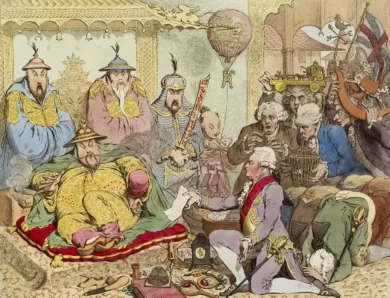
American painting is very interesting for its plurality and specialty of subjects. For instance, many similarities can be found between French, English or German paintings but American art appears to be very specific from its beginning. From great landscapes to portraits, focusing on the pictural art in America really allows one to understand the wish to build a great independent nation.
The first relevant aspect is that painters in America had the mission to build the new culture of the young United States, a culture apart from that of Europe. It was their task to create a national history and to relate to the events in process. Developing itself during the XVIII th and XIX th centuries, it is only at the very end of the century that American pieces of art started to be noticed by the Europeans. Even if the American continent was far from Europe, it is still the Europeans who imposed, at least at the beginning, their styles and genres. The great reward for an American painter was to see his art reach the European art market and to have the opportunity of working in Europe. However, this should not overshadow the singularity of American art, as its political emancipation from Europe in 1776 marks the beginning of an independent cultural and artistic movement that genuinly constitutes the bedrock of the country.
In a far away land, where nature is the central element

The early American painting art is mostly characterized by the description of the immensity of the territory. There was indeed the will to represent the intact nature that seems like a new Eden.
On top of this was the idea of subliming the work of God. Those ideas are best embodied by the painters of the Hudson River School, a movement that grouped painters influenced by romanticism and a will to find the « pristine wilderness, documenting the remnants of a natural world that was fast disappearing ». Albert Bierstadt belonged to this movement and its paintings are really representative of this.
Of course the light is important, but so is the harmony of the natural elements. The reflection of the mountains in the water deepens them and exaggerates their immensity. The darkness of the forest and the rocks on the left of the canvas also emphasize the light from above the cloud, which as we can notice, is not represented.
There is something intimate and transcendental within this art, with the wish to show something superior to man in Nature. This remarkably answers the ideas of W. R. Emerson, who published Nature, in 1836, and implemented the basis of transcendentalism. Landscape painting in America deeply echoes with those sentences taken from the introduction of the book, « Let us interrogate the great apparition, that shines so peacefully around us. Let us inquire, to what end is nature? ». This is the heart of the American landscape painting, which interrogates nature and represents it as an unsolvable mystery.

As we have mentioned, painting was also a way to tell their generation, as well as future ones, the history in process. This canvas from the same painter shows the travels to the West of the country, a major element in American history. It is by exploring and then controlling their territory that Americans succeeded in imposing themselves against the Europeans and managed to develop a specific culture. In this painting we find once again the overwhelming nature that surrounds the travelers following the sun. A warmth comes from this piece of art, and the golden sun could be interpreted as the promise of a golden future, which could of course be a reference to the gold resources of the West territories (1). Thus this painting illustrates the migration to the West but also the Gold Rush.
American natives

A great part of the XIXth century’s painting also deals with the representation of Indian tribes. It was a demand from East Americans and Europeans who were curious to see this « disappearing race ». The migration to the West caused a lot of conflicts between the settlers and the Indian tribes, conflicts that would end by the deportation of many tribes into natural reserves. The painter’s task was then to « rescue from oblivion », this « vanishing race ». Those were the words used at that time to hide the fact that a genocide was in fact in process.
Famous painters worked on this topic such as George Catlin and Elbridge Ayer Burbank who was commissioned to paint some portraits of important Indian chiefs. He made his paintings after an Indian war where most of the Indian Chiefs had been captured, but also by entering directly into the tribes. Those paintings fixed forever the daily life and cultural customs of the first inhabitants of the American territory. Their portraits are a testimony of the tragic fate of those tribes, and the fact that they were deemed incompatible with the new world building itself with modernity (2).
Traditions and values

Early in history, artists and politicians have known that art could serve a purpose and this appears to be very important when a nation is building itself. Art was a means to represent the customs of the American society, customs such as Thanksgiving for instance, but also the new traditions and values that were constitutive of the American identity. For example with the following painting from Moran, The Birth of Old Glory, two little girls are presenting the Betsy Ross iconic flag (3) to George Washington, 1st President of the United States. The canvas is the reproduction of a typical American house with even a little reference to the landscape painting in the background. It vehicles an idea of the hierarchy of the society, first the men, armed and in suits which allows us to identify them as politicians, then the woman, at home with her girls, and finally the little girls who learnt to sew with their mother. It gives the idea that everyone has their right place into the construction of the State. Here, we found the idea of the familial unit, very important for the stability of the States. It is also a representation of patriotism.
Painting in America has evolved. During the XIXth century art is dominated by Europe, that goes for painting and literature. Even with the emergence of American arts, American painters are barely considered by Europeans. For example, at the Chicago Columbian Exhibition in 1893, the art section is mostly fuelled by European pieces of art. However, during the XXth century the balance of power between Europe and the United States is changing and this drastic turn is also relevant in the artistic world.
Modernism
Instead of serving the National project which turned out to be imperialist one at the beginning of the XXth century, the artists are going to continue to focus on the American society, observe its changes and criticize its behavior.

This well-known painting, realised by Grant Wood in 1930 is part of the American Gothic painting movement. The painter said he represented an illustration of Americans. This is in fact a representation of puritanism. If we look at the clothes and the colors, they have a very purified style, there is nothing ostentatious. The house behind them is built in a gothic architecture, best exemplified by the window which echoes to religion. Then a farmer, recognizable by his pitchfork has a strong look, and a harsh aspect which both represent the hard living conditions in the countryside. The woman next to him looks at him, it is difficult to tell what her feelings are, but she looks mostly bored. We can wonder if this painting is a criticism of puritanism. However, even if puritanism is not at the heart of the criticisms, there is at least some desire to show the rural nature and the difficult living conditions of some places in America. This painting could be easily linked with the novel, Main Street published by Sinclair Lewis in 1920 which evokes the boredom of the towns built around one main street. Last but not least, we could say that this painting shows the limit of the right for property, of the gospel of Wealth, and of the discovering of the West, at the end the painters maybe wanted to say that all that was an illusion and not a way to reach happiness.
Another painter dealt with this topic of unhappiness and solitude in the American society. Edouard Hopper, known for his urban and rural scenes, with oil that represented the real life of Americans. His work brings a strong feeling of solitude and intense melancholy.

This painting is like an ode of the nighthawks that haunt the night. Living in a big city can be isolating. Although you’re at the heart of a social space, you’re more alone than in the nature. It is those considerations that Hopper wanted to represent here. The colors of oil are very dark and contrast with the gloomy lights. The city also seems empty, the only light comes from the bar in which our attention is attracted to. The underpinning idea here is that people have gained access to a good situation, have a job, but live a form of existential crisis. The 1930’s come after the Great Depression, which could appear as a moment of self-introspection for the American society.
The forgotten ones

What for the slaves is the fourth of July ? this speech given by Frederick Douglass in 1852 can be applied to the American painting. Indeed, the non-subject of the American Painting are the slaves. Very few painters worked this subject, and when they did represent slaves, it was for example at the background of a familial portrait to show the wealth of the family.
Black people were rarely represented even if they were completely a part of the American society. But as slavery was considered as the particular institution and if we think about the fact that American painting was to be exported in Europe, where countries were progressively abolishing slavery, one can easily understand why slaves were not depicted. Even though, the question remains : What is American painting for the Slaves ? it iss the tell of a history where they are ignored.
To conclude, from the beginning of the American painting we can highlight some particularities : the contemplation of Nature, the depiction of Indians, but the American art hardly imposed itself on the international art market. The European style was considered by Europe and the rest of the conquered world as the perfect one, and dominated the genres. Yet, the American artists focused on the description of a new emerging society, sharing some values and symbols far from the Europeans ones. It was a time for the creation of an artistic culture which comforted the strength of the Nation. After the the first world war, this would go on through another channel. Indeed the cinema industry will come to consecrate the American Culture with the development of Hollywood. From that point, we will see a reverse tendency in terms of the artistic global weight. But still, Art in America has always served a purpose, documented the birth of what was planned to become a great nation.
Quentin Defaut
(1) The State of California was acquired in 1848, and many gold mines were worked there.
(2) The first railroads appeared around 1830 on the West Coast and spread fastly in the country during the second part of the XIXth century.
(3) The Betsy Ross Flag, was the first flag of the US nation, the thirteen stars standing for representing the first thirteen colonies.
Sources
Websites
https://fr.wikipedia.org/wiki/Peinture_américaine
https://en.wikipedia.org/wiki/Visual_art_of_the_United_States
About landscape painting
Article from the New York Times
http://hirofineart.com/minnehaha-falls-romantic-landscape-painting-america/
https://www.nga.gov/collection/paintings/american.html
About Indian portraits :
https://dcc.newberry.org/collections/art-of-conflict-portraying-american-indians





No Comment